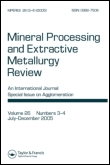
Mineral Processing and Extractive Metallurgy Review
Scope & Guideline
Transforming Mineral Resources into Technological Solutions
Introduction
Aims and Scopes
- Innovative Extraction Techniques:
The journal covers novel methodologies for the extraction of metals, including hydrometallurgical, pyrometallurgical, and biotechnological approaches. This includes the application of new reagents, methods, and technologies to enhance metal recovery. - Resource Recovery from Waste:
A significant focus is placed on the recovery of valuable metals from secondary resources, such as electronic waste, spent batteries, and mining tailings. The journal promotes research on recycling processes and sustainable practices. - Process Optimization and Modeling:
Research articles often discuss optimization techniques and modeling approaches to improve the efficiency of mineral processing operations. This includes studies on grinding, flotation, and leaching processes. - Environmental and Economic Sustainability:
The journal highlights the importance of environmentally friendly practices in mineral processing. This includes studies on minimizing waste, reducing energy consumption, and assessing the economic viability of new technologies. - Characterization and Mechanism Studies:
Papers frequently delve into the characterization of ores and the mechanisms underlying various extraction processes, providing a deeper understanding of the material properties and reaction dynamics.
Trending and Emerging
- Sustainable and Green Processing:
A significant trend is the focus on sustainable practices, including the use of biodegradable reagents and eco-friendly methods in mineral processing, reflecting a global push towards environmentally responsible mining. - Advanced Characterization Techniques:
There is an increasing emphasis on using advanced characterization techniques such as X-ray microtomography, electron imaging, and machine learning to understand mineral properties and optimize extraction processes. - Machine Learning and AI Applications:
The application of machine learning and artificial intelligence in optimizing mineral processing operations is gaining traction, with studies exploring predictive modeling and process automation. - Bioleaching and Biotechnology:
Research on bioleaching and other biotechnological methods for metal recovery is on the rise, as these methods offer greener alternatives to traditional extraction techniques. - Critical and Rare Earth Elements Recovery:
The recovery of critical and rare earth elements, particularly from secondary sources, is becoming a focal point of research, driven by their increasing importance in technology and industry.
Declining or Waning
- Traditional Pyrometallurgy:
There has been a noticeable decrease in papers focused solely on traditional pyrometallurgical processes, as the industry increasingly shifts towards more sustainable and environmentally friendly extraction methods. - Static Process Analysis:
Research that solely emphasizes static analyses or non-dynamic studies of mineral processing systems is becoming less common, as there is a growing preference for dynamic modeling and simulation approaches that provide more actionable insights. - Conventional Flotation Techniques:
The focus on conventional flotation techniques without the integration of new reagents or processes has waned, as recent publications lean towards innovative, eco-friendly, and more effective flotation methods.
Similar Journals

Kompleksnoe Ispolzovanie Mineralnogo Syra
Enhancing Efficiency in Metallurgy and Resource ManagementKompleksnoe Ispolzovanie Mineralnogo Syra is a prominent journal dedicated to the comprehensive exploration and utilization of mineral resources, contributing significantly to the fields of metallurgy and ore beneficiation. Published by the esteemed INST METALLURGY & ORE BENEFICIATION based in Almaty, Kazakhstan, this journal serves as a critical platform for researchers and practitioners seeking to advance knowledge in mineral processing and sustainable extraction methods. Although specific impact factors and H-Index data are currently unavailable, its rigorous peer-review process ensures high-quality research dissemination. The journal welcomes original research articles, reviews, and case studies that meet the scientific community's needs, all aimed at enhancing the efficiency and sustainability of mineral resource use. As an open-access publication, it strives to make significant advancements in the field accessible to a wider audience, fostering innovation and collaboration among professionals, researchers, and students alike.

Mining of Mineral Deposits
Advancing the Future of Mining ResearchMining of Mineral Deposits, published by the NATIONAL MINING UNIVERSITY in Ukraine, stands as a pivotal journal in the fields of engineering and earth sciences, evidenced by its commendable rankings across various categories, including a Q1 classification in Engineering (miscellaneous) and notable placements in Geochemistry and Geotechnical Engineering (Q2) for 2023. With an ISSN of 2415-3435 and E-ISSN 2415-3443, this journal provides a dedicated platform for researchers, professionals, and students alike to disseminate significant findings pertaining to mineral deposits and mining technologies. The journal has evolved over the years, bridging vital research gaps since its inception in 2016, and aims to enhance knowledge and collaboration within the mining community. Although it operates under limited access options, its rigorous peer-review process ensures that only high-quality research is published, all contributing to its respectable impact factor and visibility in the academic landscape. Located in Dnipropetrovsk, this journal not only serves as a repository of knowledge but also promotes advancements in sustainable mining practices and resource management, making it an essential resource for those engaged in mineral exploration and extraction.

JOURNAL OF MINING SCIENCE
Bridging Academia and Industry in Mining ScienceJOURNAL OF MINING SCIENCE, published by PLEIADES PUBLISHING INC, is a leading platform for research and development in the fields of geology, geotechnical engineering, and engineering geology. With an ISSN of 1062-7391 and E-ISSN of 1573-8736, this journal has established itself as a notable contributor to the mining and earth sciences communities since its inception in 1991. The journal is indexed in prestigious databases and currently holds a Q3 ranking in both geology and geotechnical engineering categories, recognizing the impact and quality of the research it publishes. Although it does not offer open access, it provides extensive insights from cutting-edge studies that appeal to researchers, professionals, and students alike. The Journal of Mining Science aims to disseminate significant advancements in mining technology and its environmental implications, promoting sustainability and innovation within the industry. With its comprehensive scope and commitment to excellence, this journal serves as an invaluable resource for stakeholders in academia and industry striving to enhance their knowledge and practices in mining science.

Russian Journal of Non-Ferrous Metals
Elevating Knowledge in Non-Ferrous MetalsThe Russian Journal of Non-Ferrous Metals, published by PLEIADES PUBLISHING INC, serves as a vital resource for researchers and professionals in the fields of materials science and engineering. With a dual ISSN (1067-8212 for print and 1934-970X for online), this journal has been instrumental in disseminating cutting-edge research from 2007 to 2023. Specializing in the mechanics of materials, metals and alloys, and the study of surfaces, coatings, and films, it provides invaluable insights into the latest advancements and applications in these areas. Although currently categorized in the Q4 tier for mechanics of materials and surfaces, and Q3 for metals and alloys in the 2023 rankings, its commitment to quality research is reflected in its Scopus metrics, ranking it within the competitive spectrum of its fields. While not an open access journal, it remains a crucial academic platform for fostering knowledge exchange among professionals and scholars. By publishing high-quality articles, the Russian Journal of Non-Ferrous Metals contributes significantly to the ongoing dialogue in metallurgical science and engineering.

Mineral Economics
Driving Research for a Sustainable Mineral FutureMineral Economics is a leading interdisciplinary journal published by SPRINGER HEIDELBERG, focusing on the economic aspects of mineral resources and their sustainable use. Established in 2011, this journal aims to facilitate the exchange of research on the economics of mineral exploration, extraction, and usage, addressing global challenges such as resource scarcity, environmental impacts, and policy implications. With impressive rankings placing it in the Q2 category of Economic Geology, Economics, Econometrics, and Finance, as well as Geography and Social Sciences, it occupies a vital space in academic discourse. Notably, the journal ranks in the 90th percentile in Social Sciences and 82nd percentile in Economics, indicating its relevance and scholarly impact. The journal is available without open access restrictions, ensuring that high-quality research is accessible to a broad audience. With an evolving publication timeline slated through 2024, Mineral Economics is an essential resource for researchers, practitioners, and students committed to advancing knowledge in the economics of mineral resources.

TRANSACTIONS OF THE INDIAN INSTITUTE OF METALS
Advancing metallurgy through innovative research.TRANSACTIONS OF THE INDIAN INSTITUTE OF METALS is a premier journal published by Springer India, dedicated to the field of metallurgy and materials science. Established in 1969, this journal serves as a vital platform for researchers and professionals to disseminate their findings on metals and alloys, showcasing innovative studies and experimental techniques. With an impressive impact factor and categorized in the Q2 quartile for metals and alloys as of 2023, it ranks 70 out of 176 in its field according to Scopus, placing it in the 60th percentile. The journal maintains a robust reputation for fostering academic excellence, thus attracting contributions from both established and emerging scholars. Though not an open access publication, its well-curated content remains a crucial resource for advancing knowledge and technology in metallurgy. The journal's extensive operational history, particularly during notable converged years, underscores its enduring significance in the scientific community.
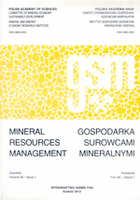
Gospodarka Surowcami Mineralnymi-Mineral Resources Management
Advancing Knowledge in Economic GeologyGospodarka Surowcami Mineralnymi-Mineral Resources Management is a pivotal academic journal published by the Polish Academy of Sciences and the Mineral and Energy Economics Research Institute. Focusing on the field of Economic Geology, this journal plays a critical role in disseminating research on mineral resources management, exploring the economic implications of mineral exploitation, sustainability practices, and technological advancements in resource extraction. With an ISSN of 0860-0953 and an E-ISSN of 2299-2324, the journal has established itself as a respected source of knowledge, holding a Q3 ranking in its category as of 2023 and demonstrating its relevance within a competitive landscape where it ranks 22nd out of 43 in Economic Geology according to Scopus. Researchers, professionals, and students will find this journal to be an invaluable resource for the latest insights and developments in mineral resource management, contributing significantly to the overarching conversations in geology and environmental science.
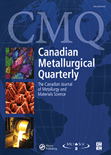
CANADIAN METALLURGICAL QUARTERLY
Pioneering Research in Materials Science.Canadian Metallurgical Quarterly is a prestigious scholarly journal published by Taylor & Francis Ltd, dedicated to the field of metallurgical engineering and materials science. With a rich history dating back to its inception in 1962 and continuing through its most recent publications, this journal serves as a vital platform for the dissemination of innovative research, advancements, and critical reviews in metallurgy, metals, and alloys. Positioned strategically within the academic community, it holds a significant impact factor and is currently rated in the Q2 category for Metals and Alloys, and Q3 in Industrial and Manufacturing Engineering as of 2023, showcasing its authoritative role in these disciplines. Although it does not offer open access, the journal remains widely recognized for its rigorous peer-review process, ensuring that published work adheres to the highest standards of scientific quality. Researchers, professionals, and students alike will find invaluable insights and contributions that drive the field forward.
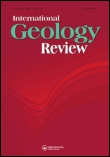
INTERNATIONAL GEOLOGY REVIEW
Unveiling the secrets of our planet, one article at a time.INTERNATIONAL GEOLOGY REVIEW, published by Taylor & Francis Inc, is a premier journal dedicated to advancing the field of geology since its inception in 1959. With its Q1 ranking in the field of Geology for 2023, this journal is a significant platform for researchers, professionals, and students exploring the intricacies of Earth and planetary sciences. The journal has been rated in the 81st percentile within Scopus rankings, reflecting its influence and the high quality of articles published. Although it does not offer Open Access options, the journal maintains a rigorous peer-review process to ensure the publication of original and impactful research. With an extensive archive projected to continue until 2024, INTERNATIONAL GEOLOGY REVIEW serves as an essential resource for those seeking to deepen their understanding of geological phenomena, making it a vital contributor to the global scientific community.
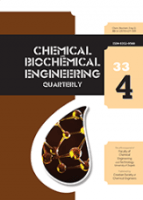
CHEMICAL AND BIOCHEMICAL ENGINEERING QUARTERLY
Bridging Academia and Industry in Chemical InnovationsCHEMICAL AND BIOCHEMICAL ENGINEERING QUARTERLY, published by the Croatian Society of Chemical Engineering Technology, is a distinguished open-access journal that has been providing a platform for the dissemination of innovative research since its inception in 1987. With a focus on the fields of biochemistry and chemical engineering, this quarterly journal addresses a wide array of topics, including process chemistry and technology, making significant contributions to both academia and industry. Despite its current positioning in the Q4 category for biochemistry and Q3 for miscellaneous chemistry and process chemistry in 2023, the journal continues to strive for greater impact, catering to researchers, professionals, and students alike. Its open-access model, in place since 2001, ensures that cutting-edge research is accessible to a broad audience, fostering collaboration and knowledge sharing within the scientific community. By promoting high-quality research and providing insights into the latest advancements, Chemical and Biochemical Engineering Quarterly remains an essential resource for those involved in the chemical and biochemical engineering disciplines.